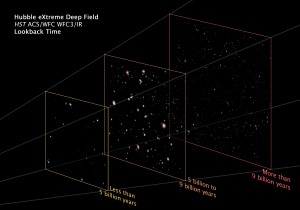
The farthest-ever view of the universe. Hubble’s “extreme Deep Field (XDF) is a composite made from 2,000 images, taken by the Hubble Space Telescope over a 10 year period. (Credit: NASA; ESA; G. Illingworth, D. Magee, and P. Oesch, University of California, Santa Cruz; R. Bouwens, Leiden University; and the HUDF09 Team)
The Hubble Space Telescope has given us the deepest view of space ever.
Called the eXtreme Deep Field, or XDF, it’s a composite of more than 2,000 photos taken by Hubble over 10 years.
“The XDF is the deepest image of the sky ever obtained and reveals the faintest and most distant galaxies ever seen. XDF allows us to explore further back in time than ever before,” said Garth Illingworth of the University of California at Santa Cruz, principal investigator of the Hubble Ultra Deep Field 2009 (HUDF09) program.
Hubble’s Advanced Camera for Surveys and its Wide Field Camera 3 focused on a tiny spot of the southern sky, which was found in the center of the original Hubble Ultra Deep Field (UDF), a composite created from Hubble Space Telescope data gathered from 2003 and 2004.
While the images that made up the UDF revealed thousands of near and very distant galaxies, the newly released full-color XDF image reaches much fainter galaxies. NASA scientists say the new XDF also contains about 5,500 galaxies which were taken within a smaller field of view than the UDF.
In creating the XDF, astronomers were able to use very deep exposures in red light taken by Hubble’s new infrared camera, which was installed by the Space Shuttle Atlantis in 2009. The data and images taken by the new camera will allow astronomers to study some of the earliest galaxies in the universe. The faintest galaxies in the XDF are one ten-billionth the brightness of what the human eye can see, according to NASA.

This illustration separates the XDF into three planes showing foreground, background, and very far background galaxies. These divisions reflect different epochs in the evolving universe. (Image: NASA, ESA, and Z. Levay, F. Summers (STScI))
The XDF not only provides a unique view of some of the deepest recesses of space but also serves as a “time tunnel into the distant past.”
The universe is believed to be 13.7 billion years old, and the XDF shows galaxies that go back some 13.2 billion years, less than 500 million years after the Big Bang. The youngest galaxy found in the XDF existed just 450 million years after the birth of the universe.
The XDF will give astronomers the opportunity to view and study those ancient galaxies when they were young, small and growing.
If you would like to learn more about the eXtreme Deep Field, the Space Telescope Science Institute (STScI), which operates the science program for the Hubble Space Telescope, is inviting the public to an online seminar Thursday, September 27, at 1700 UTC.
Three astronomers from the XDF observing team will describe how they assembled the spectacular image and explain what it tells us about the evolving universe. Participants can send in questions for the panel of experts. To participate, visit hubblesite.org.
This video explains how astronomers meticulously assembled mankind’s deepest view of the universe from combining Hubble Space Telescope exposures taken over the past decade. Guest scientists are Dr. Garth Illingworth and Dr. Marc Postman. (Video: NASA, ESA, and M. Estacion and G. Bacon (STScI))

 Science World is VOA’s on-air and online magazine covering science, health, technology and the environment.
Science World is VOA’s on-air and online magazine covering science, health, technology and the environment.
6 Responses to “Hubble Looks Into the Depths of Space and Time”
[...] the universe ever capturedEngadgetHubble telescope reveals farthest view into universe everFox NewsHubble Looks Into the Depths of Space and TimeVoice of America (blog)Toronto Star -CNET -NBCNews.comall 161 news [...]
[...] Telescope data from 2003 and 2004.Hubble telescope reveals farthest view into universe everFox NewsHubble Looks Into the Depths of Space and TimeVoice of America (blog)NASA's Hubble gazes 13.2 billion years into universe's pastZDNetBBC [...]
[...] the universe ever capturedEngadgetHubble telescope reveals farthest view into universe everFox NewsHubble Looks Into the Depths of Space and TimeVoice of America (blog)CNET -Toronto Star -NBCNews.comall 161 news [...]
I’m curious . When you say that Hubble gazes 13.2 billion years into universe . Do you mean that the image were looking at is 13.2 billion light years away ?
Exactly. The light that we see has been traveling for 13.2 billion years at the speed of light. That says that the light that hits our eyes left those galaxies 13.2 B years ago and has just arrived.
If Hubble has reached stars at 13.2 billion light years away, will we be able to see the Big Bang soon?